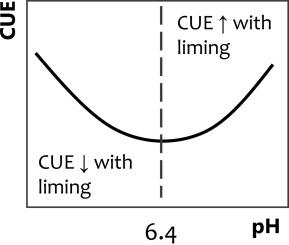当前位置:
X-MOL 学术
›
Soil Biol. Biochem.
›
论文详情
Our official English website, www.x-mol.net, welcomes your feedback! (Note: you will need to create a separate account there.)
Liming effects on microbial carbon use efficiency and its potential consequences for soil organic carbon stocks
Soil Biology and Biochemistry ( IF 9.7 ) Pub Date : 2024-01-29 , DOI: 10.1016/j.soilbio.2024.109342 Julia Schroeder , Claudia Dǎmǎtîrcǎ , Tobias Bölscher , Claire Chenu , Lars Elsgaard , Christoph C. Tebbe , Laura Skadell , Christopher Poeplau
Soil Biology and Biochemistry ( IF 9.7 ) Pub Date : 2024-01-29 , DOI: 10.1016/j.soilbio.2024.109342 Julia Schroeder , Claudia Dǎmǎtîrcǎ , Tobias Bölscher , Claire Chenu , Lars Elsgaard , Christoph C. Tebbe , Laura Skadell , Christopher Poeplau

|
Climate-smart agriculture aims amongst others at protecting and increasing soil organic carbon (SOC) stocks. The allocation of metabolised carbon (C) between soil microbial growth and respiration, i.e. C use efficiency (CUE) is crucial for SOC dynamics. We hypothesised that raising soil pH would alleviate CUE-limiting conditions and that liming could thus increase CUE, thereby supporting SOC accrual. This study investigated whether CUE can be manipulated by liming and how this might contribute to SOC stock changes. The effects of liming on CUE, microbial biomass C, abundance of microbial domains, SOC stocks and OC inputs were assessed for soils from three European long-term field experiments. Field control soils were additionally limed in the laboratory to assess immediate effects. The shift in soil pH from 4.5 to 7.3 with long-term liming reduced CUE by 40 %, whereas the shift from 5.5 to 8.6 and from 6.5 to 7.8 was associated with increases in CUE by 16 % and 24 %, respectively. The overall relationship between CUE and soil pH followed a U-shaped (i.e. quadratic) curve, implying that in agricultural soils CUE may be lowest at pH = 6.4. The immediate CUE response to liming followed the same trends. Changes in CUE with long-term liming contributed to the net effect of liming on SOC stocks. Our study confirms the value of liming as a management practice for climate-smart agriculture, but demonstrates that it remains difficult to predict the impact on SOC stocks due its complex effects on the C cycle.
中文翻译:

石灰对微生物碳利用效率的影响及其对土壤有机碳储量的潜在影响
气候智能型农业的目标之一是保护和增加土壤有机碳(SOC)储量。土壤微生物生长和呼吸之间代谢碳(C)的分配,即碳利用效率(CUE)对于SOC动态至关重要。我们假设提高土壤 pH 值将缓解 CUE 限制条件,而撒石灰可以增加 CUE,从而支持 SOC 的累积。本研究调查了 CUE 是否可以通过撒灰来控制,以及这如何影响 SOC 库的变化。通过三个欧洲长期田间实验,评估了撒石灰对 CUE、微生物生物量 C、微生物域丰度、SOC 储量和 OC 输入的影响。另外,在实验室中对田间对照土壤进行了石灰处理,以评估直接效果。长期施石灰使土壤 pH 值从 4.5 变为 7.3,使 CUE 降低 40%,而从 5.5 变为 8.6 和从 6.5 变为 7.8,CUE 分别增加 16% 和 24%。CUE 和土壤 pH 之间的总体关系遵循 U 形(即二次)曲线,这意味着农业土壤中 CUE 在 pH = 6.4 时可能最低。对石灰的即时 CUE 反应遵循相同的趋势。长期施灰导致的 CUE 变化导致了施灰对 SOC 库存的净影响。我们的研究证实了石灰作为气候智能型农业管理实践的价值,但表明由于其对碳循环的复杂影响,仍然很难预测对 SOC 储量的影响。
更新日期:2024-01-29
中文翻译:

石灰对微生物碳利用效率的影响及其对土壤有机碳储量的潜在影响
气候智能型农业的目标之一是保护和增加土壤有机碳(SOC)储量。土壤微生物生长和呼吸之间代谢碳(C)的分配,即碳利用效率(CUE)对于SOC动态至关重要。我们假设提高土壤 pH 值将缓解 CUE 限制条件,而撒石灰可以增加 CUE,从而支持 SOC 的累积。本研究调查了 CUE 是否可以通过撒灰来控制,以及这如何影响 SOC 库的变化。通过三个欧洲长期田间实验,评估了撒石灰对 CUE、微生物生物量 C、微生物域丰度、SOC 储量和 OC 输入的影响。另外,在实验室中对田间对照土壤进行了石灰处理,以评估直接效果。长期施石灰使土壤 pH 值从 4.5 变为 7.3,使 CUE 降低 40%,而从 5.5 变为 8.6 和从 6.5 变为 7.8,CUE 分别增加 16% 和 24%。CUE 和土壤 pH 之间的总体关系遵循 U 形(即二次)曲线,这意味着农业土壤中 CUE 在 pH = 6.4 时可能最低。对石灰的即时 CUE 反应遵循相同的趋势。长期施灰导致的 CUE 变化导致了施灰对 SOC 库存的净影响。我们的研究证实了石灰作为气候智能型农业管理实践的价值,但表明由于其对碳循环的复杂影响,仍然很难预测对 SOC 储量的影响。



























 京公网安备 11010802027423号
京公网安备 11010802027423号